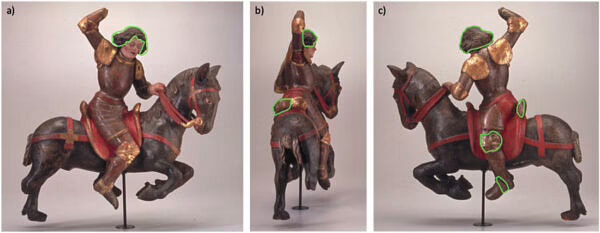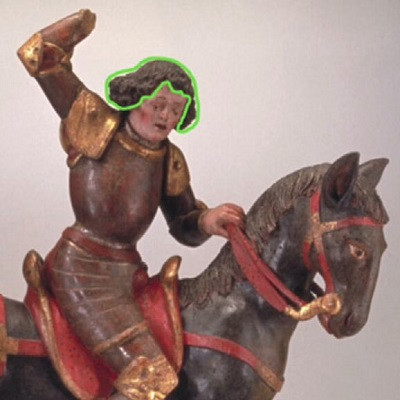Zwischgold dates back to at least the thirteenth century, when it began being used as gilding material in art from Germany and Switzerland. It is a metal foil made from a thin layer of gold over a silver backing, and could be added to sculptures or paintings, where it would create a paler tone than if one used pure gold. Zwischgold could be found applied in small sections to sculptures, altars, wall paintings and book illuminations.
While the use of Zwischgold is frequently mentioned in historical documents such as guild regulations, city statutes, and business contracts, there is little mention of them in artistic treatises, so the exact process of how it was made is still unknown. A group of several researchers from Switzerland and Germany have been studying this material and have now released a new paper detailing how these gildings are ultra-thin.

Sculpture St. George on the horse (SNM, LM13716), dated 1500, viewed from (a) front, (b) side and (c) rear. Zwischgold application is indicated with green lines.
The team examined 75 samples of Zwischgold found in late medieval items that are part of the Swiss National Museum collection. By viewing the samples through high-resolution scanning electron microscopy coupled with energy dispersive X-ray analysis (SEM-EDX), the team was able to determine their thicknesses and materials proportions.
They discovered the Zwischgold leaf would have a total thickness of between 50 and 260 nanometres (nm), with its gold layer being between 20 and 50 nm. The nanometre is an incredibly small unit of measurement, the equivalent of one-billionth of a metre. The Zwischgold layers would be classified as ultra-thin and a form of nanotechnology. By way of comparison, the width of a human hair is between 80,000 and 100,000 nanometres.
The team also found that the ratio between silver and gold used in medieval Zwischgold ranged between 1:2 to 6:1, with the peak occurrence at 3 parts silver to 1 part gold. Historical sources had suggested that the silver content of Zwischgold was much higher, but the researchers note that some of the silver may have been removed during the cleaning of these objects.
The researchers note that the creation of these ulta-thin layers of Zwischgold indicates the “employment of high-precision technologies in manufacturing of delicate art materials in the late medieval period.” However, the exact method used is unknown, and it may be the reason why Zwischgold gilding was kept as a trade secret and not written about more in medieval treatises.
Because silver was much cheaper than gold in the medieval period, using Zwischgold would have been less expensive than just using gold leaf for artworks. However, since this nanotechnology would have needed more expertise and specialized materials, the cost of their production would probably have been similar to the use of gold. The researchers hope that more work can be done to help understand just why Zwischgold would have been used by medieval artisans.
The article, “Medieval nanotechnology: Thickness determination of Zwischgold samples,” appears in the Journal of Cultural Heritage.
Read the original article on Medievalists.
